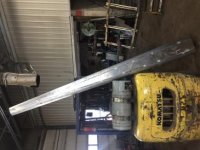Ries said it best.
This is one of many examples in modern life where we've grown accustomed to things that have shapes and sizes we take for granted....but in reality they're very difficult to make until you invest a few million dollars in tooling....then they're not too bad.
An automobile fender is a good example.
Most machinist and fabricators have had someone show up with a common item they want made....only to be told by the machinist or fabricator that it can't be made....at least not without lots of suffering, time, and money.
How will you make a decent mast for not too much money or effort? You won't.
If it was me...I'd talk to people who are already making them...or something similar like flagpoles....and spend my time begging their asses to make a one-off for me. They'll give you a 'get lost' price....all that is left is for you to find a way to cover it.
Well, for me, guythatbrews said it best, because he actually suggested a very viable idea. Look, I don't mean to be rude, since I'm asking for help, but discouraging and saying "can't be done", when just a few posts above people are actually suggesting good ideas how it could be done, doesn't add very much to the discussion. I am well aware that what I'm asking is difficult, but maybe not impossible with the right approach.
Like I wrote before, I am trying to figure out new cheap and easy ways to build various parts of sailboats for our community. We already had quite a few discoveries that allowed us to build various hardware at 1/10 of the price of the commercial alternatives. So "finding a way to cover the cost" is the very opposite of what I'm trying to achieve here.
The pressure applied must cause a hoop stress sufficient to overcome the yield strength of the tube causing it to expand. Hoop stress for a thin tube = P*r/t. Depending on the radius and wall thickness, a high pressure washer might do it.
6060 is not a strong alloy. It is a poor choice for this application.
Thanks for the formula, I'll run some calculations on this. As for the alloy - yeah, I know it is terrible. But like I said, it is the only alloy available for purchase around here. During my boatbuilding adventures, I spent insane amount of time sourcing materials, so believe me, I looked everywhere. You can get better alloys if you order a truckload of it, so in the end it just doesn't justify it for home-builders.
I would try to figure out a way to use the woodworking track saw concept where the saw rides on a linear rail.
The tubing would have to be held in place and secured to keep it straight and the saw rail can be positioned over the tubing to accommodate cutting the slight taper. The saw would either be attached to the rail with a bearing or it would ride on top of it. The rail could be round or flat, the challenge would be accommodating the length. Might have to use a shorter rail and reposition it for several cuts.
To close the tubing for welding I would try to make some dies close to the OD of the tubing, possibly out of wood by cutting holes with a hole saw then splitting the pieces in half for the two dies. Make a bunch and slowly draw them together with clamps along the length of the mast and tack it together once it's closed sufficiently. Would probably create more of a teardrop shape.
Great advice, thank you. I will definitely try this on the small-scale experiment.


 Unfortunately, taper is absolutely essential, it's the whole point of this.
Unfortunately, taper is absolutely essential, it's the whole point of this. I have no idea of the forces involved in this process, and I wonder if it is possible to substitute a construction as rigid as in these videos with a less rigid jig but making more passes. Though I suppose there is a minimum amount of force required to overcome the elastic modulus of aluminum in order to get any kind of permanent deformation. It probably goes without saying that this is beyond the scope of a DIY?
I have no idea of the forces involved in this process, and I wonder if it is possible to substitute a construction as rigid as in these videos with a less rigid jig but making more passes. Though I suppose there is a minimum amount of force required to overcome the elastic modulus of aluminum in order to get any kind of permanent deformation. It probably goes without saying that this is beyond the scope of a DIY?